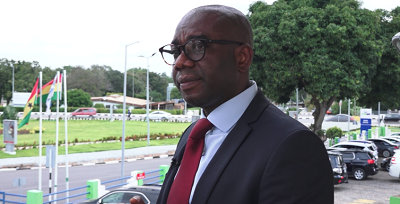Features
GACL’s letter to McDan: Causing ‘confusion’?

The Ghana Airports Company Limited (GACL) is reported to have ‘shut down’ the operations of the McDan private jet terminal at the Kotoka International Airport.
This was barely five days after McDan Aviation Company opened the private jet terminal at the Kotoka International Airport (KIA) in Accra, on January 28, 2022.
McDan Aviation CEO
Managing Director of GACL
McDan Aviation is reported to have defied the orders of GACL to halt the inauguration of the new private jet terminal on January 28, 2022.
Reportedly, the Chief Executive Officer of McDan Group of Companies, Mr Daniel McKorley, has confirmed the shutdown of operations of his private jet terminal, assuring that McDan Aviation will ‘engage’ GACL in the ensuing impasse.
The GACL accuses McDan of inaugurating his private jet terminal without following its orders of postponement.
GACL’s letter to McDan Aviation, signed by its Managing Director, Mr Yaw Kwakwa, ordered postponement of the inauguration of the private jet terminal because the arrangements made for the inauguration had not been approved by GACL , insisting that the event posed some safety and security concerns at the Kotoka International Airport.
GACL says, it made efforts to meet McDan Aviation so as to discuss matters regarding the opening of the private jet terminal but no official from McDan Aviation turned up for the proposed meetings.
GACL’s letter to McDan Aviation said: “One major example relates to your commencement of construction of the private jet terminal without a plan of Construction Operation approval from GACL.”
The letter further said: “We only became aware of your construction activities during our routine security patrols, and we had to ask you to stop and submit a Plan of Construction Operation for review and approval before construction continued.”
GACL’s letter again revealed that: “McDan Aviation through its actions disregarded the norms of doing business in the aviation sector, which requires strict adherence to safety and security concerns.”
The letter to McDan Aviation was copied to the Transport Minister, the Minister of National Security, the National Security Coordinator and the Director, Aviation Security.
The letter said:”GACL is unable to support the inaugural event until we iron out all the necessary issues and you prove to us that you fully understand and appreciate how things are supposed to be done in the aviation sector, in the interest of safety and security.”
A security analyst after examining GACL’s letter to McDan, however, asks: “So does it imply that the GACL has no technology to detect any ‘illicit’ construction activity which falls within the boundaries of the Kotoka International Airport?
“And that until ‘routine security patrols’ are undertaken by the Aviation Security, even terrorists or mercenaries can construct ‘properties’, including tunnels within the boundaries of the Kotoka International Airport? In this age of computer technology and digitisation?”
The security analyst adds:”The GACL’s letter signed by its Managing Director and addressed to McDan Aviation, exposes a serious security threat at the Kotoka International Airport,” stressing that, “this security threat must be urgently addressed.”
A retired public servant also examines GACL’s letter to McDan and queries: “So, in effect, McDan defied the orders of GACL and continued the construction of the private jet terminal until the completion and inauguration of the project?
“And like what the District Assemblies incompetently do; the GACL authorities were also looking on ‘sheepishly’ until the ‘illegal project’ was executed, completed and launched ?
“What is the mandate of GACL in the development of airports in the country?
“Is the current management of GACL too weak to have sanctioned McDan Aviation right from the outset of the project or the management was just afraid of the company?
“May I also ask: Were some politicians hiding behind McDan to do what he did ?”
McKweku Ayoo, a level 400 Business Student of the University of Cape Coast has also expressed surprise about GACL’s letter to McDan.
He quiries: “Did GACL management seek advice from its Board of Directors when McDan flouted its orders to ‘stop work’ and continued his construction activities at the Kotoka International Airport?
“If the GACL management sought advice from its Board of Directors, what was the nature of the advice?
“To allow McDan to complete and inaugurate the private jet terminal, before ‘crying out’ to the nation?
“What was also the principle of ‘state-corporate’ collaboration among key stakeholders, including Ministry of Transport, Ministry of National Security and State-Interest Governance Authority?
“Did the key stakeholders just stand-by , observing the ‘fight’ or ‘quarrel’ between GACL and McDan Aviation, without any ‘productive’ intervention ? And in whose interest? “
Ataa-Nii, a well-educated Accra taxi-driver also says:”McDan and his company must also talk so that we hear their side of the whole story.
“They must also issue a press release to the public, otherwise, from the tone of the GACL’s letter, the impression is created that McDan and his company are bullies, arrogant and disrespectful to the laws of the Republic of Ghana.”
Readers, much as this column shares the sentiments expressed by Ataa-Nii, we equally urge the Government to quickly intervene to resolve the impasse between GACL and McDan , since the project ‘in dispute’ can support Ghana in so many ways ; if it is properly guided ‘to thread’ the ‘appropriate channels’ to take-off.
Contact email/ WhatsApp of author:
asmahfrankg@gmail.com (0505556179)
BY G. FRANK ASAMAH
Features
Ghana becoming a developed nation
In a country like ours in which we are aware of our challenges, all that is required is focusing on strengthening our institutional processes by making them more robust and transparent. In this regard, investment in digitilisation must be prioritised since the human element to cut corners is inherent in the psyche of some people and therefore cannot be trusted to do the right things out of their own volition.
Enforcement of existing laws and regulations must be reviewed to see what is working, which ones have to be tweaked to be able to address current challenges, and those that have become obsolete and must be discarded.
One issue that needs to be given priority attention is remuneration. A former President is alleged to declare that we pretend to pay workers and they also pretend to work. This indeed sums up the quandary facing government after government. Workers’ salaries are crucial in the fight against corruption. A realistic living wage must be given to workers; otherwise, they will seek avenues to address their personal budget deficit.
On day one, what should engage the attention of government is Energy, making it available and affordable. The industrialisation agenda cannot be successfully executed without power that is readily available, reliable, and affordable. Solar energy must be factored in the quest for affordable and reliable power for industry.
The fuel sector issues must be urgently addressed so that it can impact positively on the transportation sector, which plays a key role in the supply of goods and services. The railway infrastructure plan linking places like Boankra Inland Port to prolong the lifespan of our roads and to fast track distribution of goods from the Capital City to the inland areas of the country should be a top priority item.
A well-structured system linking industry to academia must be quickly established to serve as a catalyst towards the industrialisation drive. Research findings from the universities must be channelled to captains of industry in a timely manner. Effective channels of communication should be established to facilitate shorter product-to-market times.
An effective mechanism for fishing out needy but talented children must be established, as well as a sponsorship package for talented individuals who are needed for certain critical areas of the economy — what I term critical investment in education.
Certain changes must be made in the constitution, particularly the appointment of the heads of certain constitutional bodies or institutions. This is to ensure that the Executive arm of government does not wield too much power to ensure accountability and checks and balances really work.
The Attorney General’s Office must be detached from the Executive arm of government. The Nolle Prosequi provision must also be amended to compel the Attorney General to give an explanation of why he or she is declining to prosecute a particular case or discontinue it. The provision that protects sitting Presidents from prosecution must also be reviewed.
The punishment for some of our laws needs a review. We must review the removal of CJ provision to ensure the independence of the Judiciary.
Above all, there must be a mindset of change, i.e., a paradigm shift from inability to capability. Inferiority complex must give way to a pacesetters mentality, and all will be well. God bless.
NB: KOTOKA INTERNATIONAL AIRPORT TO KOFI BAAKO INTERNATIONAL AIRPORT
BY LAUD KISSI-MENSAH
Join our WhatsApp Channel now!
https://whatsapp.com/channel/0029VbBElzjInlqHhl1aTU27
Features
The impact of emotional surgery and emotional elysium on neurological and neurosurgical procedures
Abstract
THIS comprehensive review aims to explore the impact of emotional surgery and emotional elysium on neurological and neurosurgical procedures. We examine the scientific literature on these approaches, including their definitions, theoretical frameworks, and applications. Our analysis highlights the potential benefits and risks of these approaches and discusses their implications for practice.
Introduction
Neurological and neurosurgical procedures are complex and delicate, requiring precision and accuracy to achieve optimal outcomes. Emotional surgery and emotional elysium are two innovative approaches that have the potential to enhance the success of these procedures. Emotional surgery involves the use of art and other creative techniques to promote relaxation and reduce stress, while emotional elysium focuses on cultivating positive emotions and promoting emotional well-being.
The Role of Emotional Surgery in Neurological and Neurosurgical Procedures
Emotional surgery has been shown to be effective in reducing anxiety and stress in patients undergoing neurological and neurosurgical procedures. By promoting relaxation and reducing stress, emotional surgery can help patients prepare for procedures, leading to improved outcomes and faster recovery times.
The Role of Emotional Elysium in Neurological and Neurosurgical Procedures
Emotional elysium has been shown to be effective in promoting emotional balance and resilience in patients undergoing neurological and neurosurgical procedures. By cultivating positive emotions and promoting emotional well-being, emotional elysium can help patients cope with the stress and trauma associated with these procedures, leading to improved outcomes and enhanced quality of life.
Benefits of Emotional Surgery and Emotional Elysium
The benefits of emotional surgery and emotional elysium in neurological and neurosurgical procedures are numerous. These approaches can:
- Reduce anxiety and stress: Emotional surgery and emotional elysium can help patients manage anxiety and stress, leading to improved outcomes and faster recovery times.
- Improve emotional regulation: Emotional surgery and emotional elysium can help patients regulate their emotions, leading to improved mental health and well-being.
- Enhance patient experience: Emotional surgery and emotional elysium can improve the patient experience, leading to increased satisfaction and improved outcomes.
Conclusion
In conclusion, emotional surgery and emotional elysium are two innovative approaches that have the potential to enhance the success of neurological and neurosurgical procedures. By reducing anxiety and stress, promoting emotional balance and resilience, and improving patient experience, these approaches can lead to improved outcomes and enhanced quality of life for patients undergoing these procedures.
Recommendations
- Further research is needed: More research is needed to fully understand the benefits and risks of emotional surgery and emotional elysium in neurological and neurosurgical procedures.
- Integration into practice: Emotional surgery and emotional elysium should be considered for integration into practice, as they may offer a valuable tool in the treatment of a range of neurological and neurosurgical conditions.
By exploring innovative approaches like emotional surgery and emotional elysium, we can improve patient outcomes and enhance the quality of life for individuals undergoing neurological and neurosurgical procedures.
BY ROBERT EKOW GRIMMOND-THOMPSON







